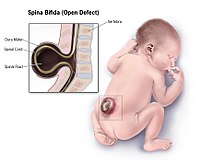
Photo from wikipedia
PURPOSE The purpose of this study was to assess if the incidence of lower extremity (LE) pressure injuries resulting in amputations was more frequent in ambulatory versus non-ambulatory patients with… Click to show full abstract
PURPOSE The purpose of this study was to assess if the incidence of lower extremity (LE) pressure injuries resulting in amputations was more frequent in ambulatory versus non-ambulatory patients with spina bifida. METHODS The medical records of all patients at a large pediatric rehabilitation hospital who had spina bifida and a history of a pressure injury between 1997-2018 were retrospectively reviewed. RESULTS In this study, 112 patients with spina bifida developed LE pressure injuries, 53 patients walked with braces and/or an assistive device, and 59 patients used a wheelchair for mobility. Of the 11 patients who had amputations, 10 walked and 1 did not walk prior to their amputation. Ambulatory patients with LE pressure injuries had a 19% chance (10 out of 53 patients) of requiring an amputation. Non-ambulatory patients with a LE pressure injury had only a 2% chance (1 out of 59 patients) of requiring an amputation. Ambulatory patients with LE pressure injuries were at a much higher risk of requiring an amputation than patients who did not walk (p-value of < 0.005). CONCLUSION Patients with spina bifida who are ambulatory and develop a pressure injury have a high risk of ultimately needing an amputation and should be monitored and treated aggressively.
Journal Title: Journal of pediatric rehabilitation medicine
Year Published: 2022
Link to full text (if available)
Share on Social Media: Sign Up to like & get
recommendations!